
Meliaceae, the mahogany family, is a flowering plant family of mostly trees and shrubs in the order Sapindales.

Acanthaceae is a family of dicotyledonous flowering plants containing almost 250 genera and about 2500 species. Most are tropical herbs, shrubs, or twining vines; some are epiphytes. Only a few species are distributed in temperate regions. The four main centres of distribution are Indonesia and Malaysia, Africa, Brazil, and Central America. Representatives of the family can be found in nearly every habitat, including dense or open forests, scrublands, wet fields and valleys, sea coast and marine areas, swamps, and mangrove forests.
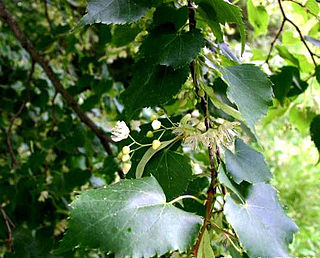
Tilia cordata, the small-leaved lime or small-leaved linden, is a species of tree in the family Malvaceae, native to much of Europe. Other common names include little-leaf or littleleaf linden, or traditionally in South East England, pry or pry tree. Its range extends from Britain through mainland Europe to the Caucasus and western Asia. In the south of its range it is restricted to high elevations.

Aleurites is a small genus of arborescent flowering plants in the Euphorbiaceae, first described as a genus in 1776. It is native to China, the Indian Subcontinent, Southeast Asia, Papuasia, and Queensland. It is also reportedly naturalized on various islands as well as scattered locations in Africa, South America, and Florida.
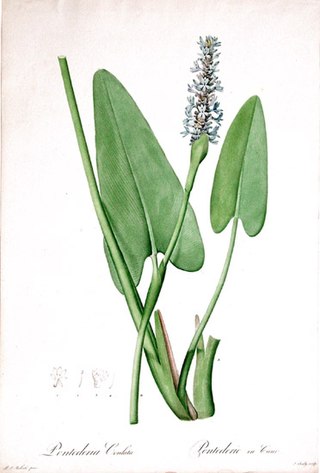
Pontederia is a genus of tristylous aquatic plants, members of which are commonly known as pickerel weeds. Pontederia is endemic to the Americas, distributed from Canada to Argentina, where it is found in shallow water or on mud. The genus was named by Linnaeus in honour of the Italian botanist Giulio Pontedera.
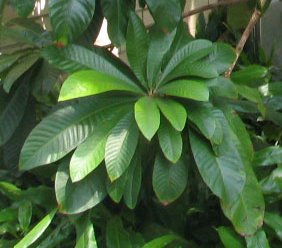
The Sapotaceae are a family of flowering plants belonging to the order Ericales. The family includes about 800 species of evergreen trees and shrubs in around 65 genera. Their distribution is pantropical.

Sapote is a term for a soft, edible fruit. The word is incorporated into the common names of several unrelated fruit-bearing plants native to southern Mexico, Central America and northern parts of South America. It is also known in Caribbean English as soapapple.
Phelline is a genus of shrubs and the sole member of the family Phellinaceae, a family of flowering plants endemic to New Caledonia. It is placed in the order Asterales and is related to two other small plant families: Alseuosmiaceae and Argophyllaceae. It contains ten species.

Houttuynia cordata, also known as fish mint, fish leaf, rainbow plant, chameleon plant, heart leaf, fish wort, or Chinese lizard tail, is one of two species in the genus Houttuynia. It is a flowering plant native to Southeast Asia. It grows in moist, shady locations. It was named after Martinus Houttuyn.
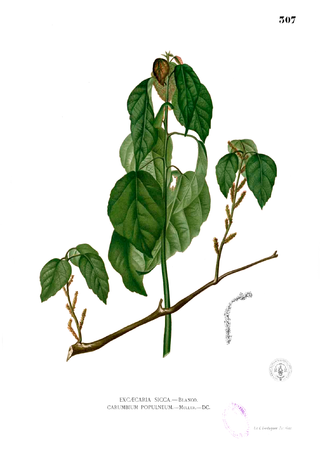
Alchornea is a plant genus of the family Euphorbiaceae first described as a genus in 1788. It is widespread in tropical and subtropical regions of Africa, South Asia, Australia, Latin America, and various oceanic islands. Molecular phylogenetic analyses suggest that Bocquillonia from New Caledonia is nested in Alchornea.
Conceveiba is a plant genus of the family Euphorbiaceae, first described as a genus in 1775. It is native to South America and Central America.
- Conceveiba guianensisAubl. - Brazil, Peru, Bolivia, Ecuador, Colombia, Venezuela, 3 Guianas
- Conceveiba hostmaniiBenth. - Guyana, Suriname, Amazonas State in Brazil
- Conceveiba krukoffiiSteyerm. - Venezuela, French Guiana, NW Brazil
- Conceveiba latifoliaBenth. - Colombia, Venezuela, Peru, Amazonas State in Brazil
- Conceveiba martianaBaill. - Venezuela, French Guiana, NW Brazil, Colombia, Ecuador, Peru, Bolivia
- Conceveiba maynasensisSecco - Loreto in Peru
- Conceveiba parvifoliaMcPherson - Panama, NW Colombia
- Conceveiba pleiostemonaDonn.Sm. - Costa Rica, Nicaragua, Colombia, Venezuela
- Conceveiba praealta(Croizat) Punt ex J.Murillo - NW Brazil
- Conceveiba ptariana(Steyerm.) Jabl. - S Venezuela
- Conceveiba rhytidocarpaMüll.Arg. - Colombia, Ecuador, Peru
- Conceveiba santanderensisJ.Murillo - NW Colombia
- Conceveiba terminalis(Baill.) Müll.Arg. - Venezuela, Guyana, Suriname, NW Brazil, Colombia, Peru
- Conceveiba tristigmataJ.Murillo - Colombia, Venezuela, NW Brazil
Sphaerostylis is a genus of plant of the family Euphorbiaceae first described as a genus in 1858. The entire genus is endemic to Madagascar.
- Sphaerostylis perrieriLeandri
- Sphaerostylis tulasneanaBaill.
Zuckertia is a genus of plant of the family Euphorbiaceae first described as a genus by Henri Ernest Baillon in 1858.

Sterculia is a genus of flowering plants in the mallow family, Malvaceae: subfamily Sterculioideae. Members of the genus are colloquially known as tropical chestnuts. Sterculia may be monoecious or dioecious, and its flowers unisexual or bisexual.

Brongniartia is a genus of leguminous plants in family Fabaceae. It includes 63 species native to Mexico and Texas and to Bolivia. The genus was first named by Kunth after the French botanist Adolphe Brongniart.
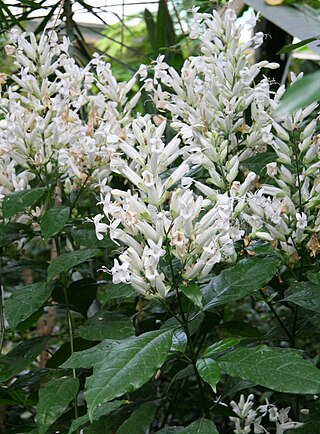
Whitfieldia is a genus of flowering plants in the family Acanthaceae. It includes 13 species of erect or scrambling shrubs native to tropical Africa. The greatest species diversity is in the Guineo-Congolian rainforests of western and central Africa.

Chrysophylloideae is a subfamily of flowering plants in the chicle family, Sapotaceae.

Periploca is a genus of plants in the family Apocynaceae, first described for modern science by Linnaeus in 1753. It is native to Europe, Asia, and Africa.
- Periploca aphyllaDecne. - Middle East from Sinai to Pakistan
- Periploca calophylla(Wight) Falc. - S China, Nepal, Bhutan, Assam, E Himalayas, Vietnam
- Periploca chevalieriBrowicz - Cape Verde Islands
- Periploca chrysanthaD.S. Yao, X.D. Chen & J.W. Ren - Gansu Province in China
- Periploca floribundaTsiang - Yunnan, Vietnam
- Periploca forrestiiSchltr. - Guangxi, Guizhou, Qinghai, Sichuan, Tibet, Yunnan, India, Kashmir, Myanmar, Nepal
- Periploca graecaL. - Mediterranean
- Periploca hydaspidisFalc. - Kashmir
- Periploca laevigataAiton - Canary Islands, Savage Islands
- Periploca linearifoliaQuart.-Dill. & A. Rich - Ethiopia
- Periploca nigrescensAfzel. - W Africa
- Periploca refractifoliaGilli - Tanzania
- Periploca sepiumBunge - widespread across much of China
- Periploca tsiangiiD. Fang & H.Z. Ling - Guangxi Province in China
- Periploca visciformis(Vatke) K. Schum. - Somalia

Pyrus cordata, the Heart-leaved pear or Plymouth pear, is a rare wild species of pear belonging to the family Rosaceae. It gets its name in Spanish, Portuguese and French from the shape of its leaves. In the UK, it is known as Plymouth Pear after the city of Plymouth in Devon, where it was originally found in 1870 The Plymouth pear was one of the British trees to be funded under English Natures Species Recovery Programme.

Bia is a genus of plant of the family Euphorbiaceae first described as a genus in 1841. The entire genus is native to South America.
- Bia alienataDidr. - Brazil, Bolivia, Paraguay, N Argentina
- Bia capivarensisMedeiros & Alves - Serra da Capivara
- Bia fallax(Müll.Arg.) G.L.Webster - Peru, Rondônia
- Bia fendleri(Müll.Arg.) G.L.Webster - Guyana, Venezuela, Amazonas State of Brazil
- Bia lessertianaBaill. - Fr Guiana, Suriname, Guyana, N Brazil
- Bia manueliiV.W. Steinm. & Ram.-Amezcua, 2013, Sierra de Coalcomán, Michoacán, Mexico














